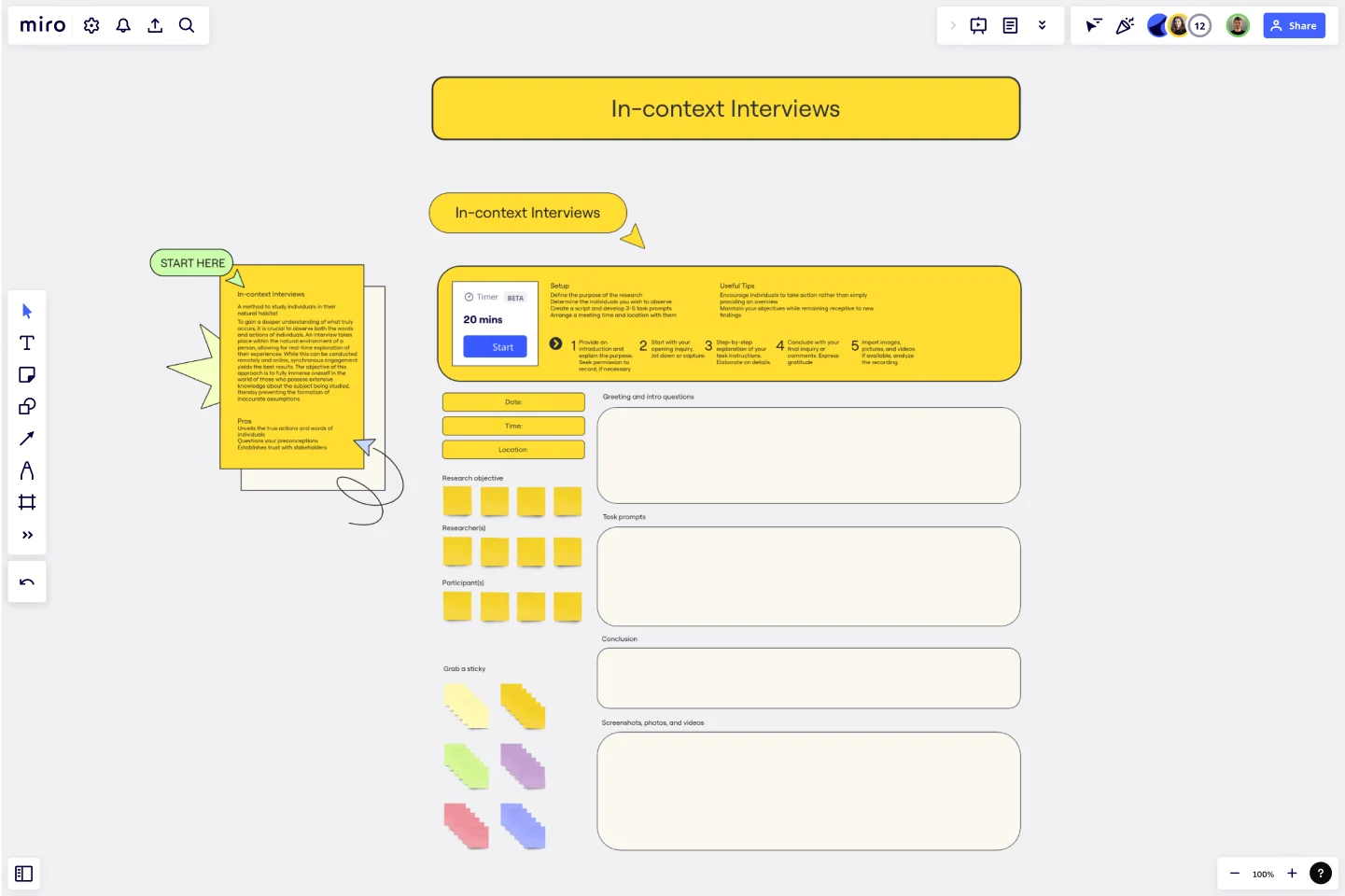In-Context Interviews Template
Gain a deeper understanding of what truly occurs with people in their natural habitat with the In-Context Interviews Template.
About the In-context Interviews Template
The In-Context Interview Template helps you study individuals in their natural habitat. To gain a deeper understanding of what truly occurs, it is crucial to observe both the words and actions of individuals.
An interview takes place within a person's natural environment, allowing for real-time exploration of their experiences. While this can be conducted remotely and online, synchronous engagement yields the best results.
The objective of this approach is to fully immerse oneself in the world of those who possess extensive knowledge about the subject being studied, thereby preventing the formation of inaccurate assumptions.
Benefits of using the In-context Interviews Template
Unveil the true actions and words of individuals.
Question your preconceptions.
Establish trust with stakeholders.
How to use the template in Miro
Provide an introduction and explain the purpose. Seek permission to record, if needed.
Start with the opening inquiry. Jot down or capture.
Step-by-step exploration of your task instructions. Elaborate on details.
Conclude with your final inquiry or comments. Express gratitude.
Import images, pictures, and videos. If available, analyze the recording.
Setup
Define the purpose of the research.
Determine the individuals you wish to observe.
Create a script.
Useful tips
Encourage individuals to take action rather than simply providing an overview.
Maintain your objectives while remaining receptive to new findings.
Get started with this template right now.
Empathy Mapping With AI Assistance
Works best for:
Research & Design, Market Research
Empathy Mapping AI Assistance template combines traditional empathy mapping with AI insights. This innovative approach helps you understand user needs by integrating data-driven insights with human empathy. Use this template to enhance your product development process and create more personalized user experiences.
Empathy Map by Back of the Napkin Consulting
Works best for:
Research & Design, Market Research
The Empathy Map template is designed to help you understand your users deeply. It captures user behaviors, thoughts, and feelings, allowing you to design products that truly resonate with their needs. Use this template to enhance your UX research and create user-centered designs.
Empathy Map Canvas by Sampriti Jain
Works best for:
Market Research, Strategy & Planning
The Empathy Map Canvas template allows you to explore user behaviors and emotions comprehensively. It’s designed to help you visualize user experiences and create solutions that truly meet their needs. Perfect for UX teams and product developers.
Design Research Template
Works best for:
UX Design, Design Thinking, Desk Research
A design research map is a grid framework showing the relationship between two key intersections in research methodologies: mindset and approach. Design research maps encourage your team or clients to develop new business strategies using generative design thinking. Originally designed by academic Liz Sanders, the framework is meant to resolve confusion or overlap between research and design methods. Whether your team is in problem-solving or problem space definition mode, using a research design template can help you consider the collective value of many unrelated practices.
Empathy Map Trevotech
Works best for:
Market Research, Research & Design
Empathy Map Trevotech is a powerful tool for gaining insights into user experiences. It helps you capture and analyze user emotions, thoughts, and behaviors, ensuring your product designs meet user needs effectively.
Bird's Eye View Observation Template
Works best for:
UX, Design
The Bird's Eye View Template helps you to observe people without interrupting them. This approach is useful when you cannot communicate with people directly or want to avoid disrupting their activities. By minimizing your impact, you can maximize your discoveries. The objective is to observe and listen without intervening. Direct observation, as well as video and screen recordings with prior consent, can be valuable.
